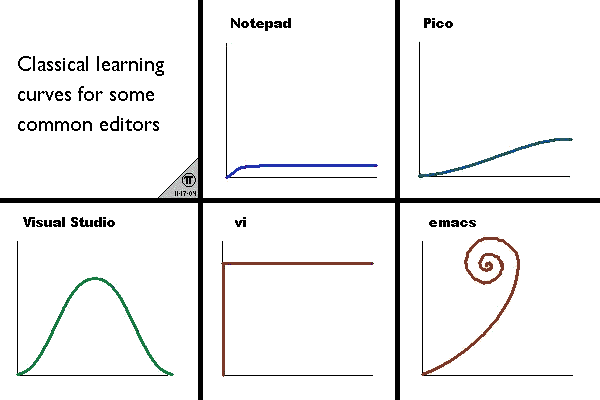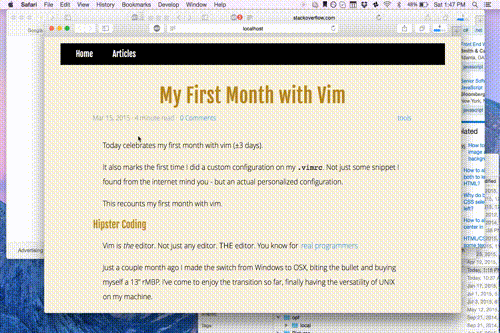My First Month with Vim
Today celebrates my first month with vim.
It also marks the first time I did a custom configuration on my .vimrc. When I said ‘custom’ it means that it was not just some snippet I found from the internet, it was an actual, personal configuration that made ‘vim’ my own flavor of ‘vim’. This, I think, is the point when someone can say they have graduated from vim noob, to vim user.
Hipster Coding
Vim is the editor. Not just any editor. THE editor. You know for real programmers
Just a couple of months ago I made the switch from Windows to OSX, biting the bullet and buying myself a 13” rMBP. I’ve come to enjoy the transition thus far, finally having the versatility of UNIX on my machine.
The more than positive experience of switching OS made me want to experiment with my tools more, and seeing Jonathan Blow programming on Emacs inspired me to switch to these classic editors. I already used Emacs back in the day, and while it is a good editor, I was looking for something a little more lightweight and nimble. Working with Javascript most of the time, I would much prefer a speedy editor like Vim against fancy IDE features that Emacs could offer.
The Learning Curve and Progressive Hacking
I was intimidated at first. Vim is well known to have a pretty brutal learning curve, and I had contracts whose deadlines won’t extend to account for me learning a new editor. This was a potential show-stopper right from the get go.

This image is as classic as the editors themselves
I figured though - when would I ever just commit to learning vim? I’ve programmed enough to know that perfect opportunities to learn things never really present themselves, so I decided to learn it just like how one would learn a new framework or language, by just effin’ using it
My vim story started by me using vim just like how I would use any other editor. My first day was spent scrolling around and clicking on things, all to no avail (I was running on a terminal, and vim doesn’t support mouse events by default). I pretty much never touched normal mode at all, spending most of my time in insert mode and moving along with the arrow keys. Searching for a string in my project involved a (rather pathethic) workflow of having sublime text running in the background, where I could quickly use ‘find in files’ in the familiar GUI.
After a few days, I switched from using cursor keys to hjkl keys, and I learned how to use :edit to switch files without closing and reoping vim all the time. Eventually I installed my first ever plugin, NERDTree which added the much needed file navigation system.
You see, I made it a point to progressively learn vim, and that involved grabbing packages and learning things only when I found that I ‘needed’ them.
This philosophy pretty much defined how I learned vim. Editing properties in json files made me learn ci, and looking into more efficient insert commands made me learn o, I, and A. Maintaining a javascript codebase with variable indent widths made me learn the very first big trick that made me go wow - gg=G (indent the whole file). The idea that the whole thing relies on individual commands made it more awesome - gg goes to the start of the file, = indents, and G goes to the end of the file. After learning that, I found myself using = more, such as with v and %
Vim had an admittedly steep learning curve, but I don’t really think it is as hard as a lot of people claim it to be, as long as you take it in incrementally. I found it only a little bit harder to use than a ‘dumb editor’, it’s more complicated features hidden around esoteric commands, waiting for you to discover them.
Eventually, as I got more comfortable with vim, I went on adding more features that I needed through plugins one by one.
As a slave to aesthetics, the second plugin (which is really a theme) that I added is the Solarized theme. This also made me switch to iTerm, which, apart from supporting 256 colors, also had an excellent show/hide feature that can be keybound. This, with iTerm’s (also keybind-able) fullscreen feature gave me an unparalleled productivity boost.

My editor is an alt space away
YouCompleteMe provided some much needed auto complete. Fugitive was used for Git, and I finally learned how to use Ack to search for things. Linters? Syntastic. Code expand? Emmet. Et cetera, et cetera.
I found my slow growth of skill in vim incredibly exciting. Eventually, I found myself more productive than my previous Atom/Sublime using self.
I can definitely see it as one of the best investments I ever made.